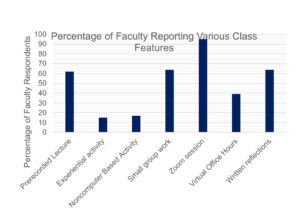The Office of Analysis and Decision Support (OADS) and the Center for New Designs for Learning and Scholarship (CNDLS) have completed two rounds of surveys of Georgetown faculty and students who are involved in remote classes this semester.
These surveys followed an extraordinary effort of faculty in CNDLS summer workshops and in the various MCEF-CNDLS Friday Forum sessions. The focus of these meetings was dissemination of novel techniques for instructors, using the various platforms available to students and faculty in remote learning. The class designs that resulted are much more diverse than the traditional image of a university course. For example, the image below provides reports of faculty respondents in what techniques they’re using in their classes.
 Zoom is clearly a dominant feature of Georgetown fall courses, but a mix of synchronous and asynchronous combined with small group work and reflective exercises are fairly common. From other information, it’s clear that faculty are spending more time on their courses, to care for the welfare of their students.
Zoom is clearly a dominant feature of Georgetown fall courses, but a mix of synchronous and asynchronous combined with small group work and reflective exercises are fairly common. From other information, it’s clear that faculty are spending more time on their courses, to care for the welfare of their students.
The faculty and students face challenges: It’s difficult to read body language with the limited visual cues possible in internet-based video interactions. Zoom fatigue is real. So, some faculty are breaking up the class into smaller series of activities, some of which are off-line. Group work can be mounted in a variety of ways, some of which take students off Zoom for the work. Faculty also report spending more hours on classes, some of which is devoted to managing both asynchronous and synchronous features. Some report their time spent in small group and one-on-one interactions with students is larger than they had with in-person courses. Much of this, I suspect, arises from the deep devotion of Georgetown faculty to the individual formation of each student.
On the other hand, many faculty report that they feel more comfortable with the technology this semester versus their experience in the spring semester. Over the summer, with the help of CNDLS workshops, the techniques have created for students a variety of activities within a class, increasing engagement of students. Those taking advantage of the instructional technology aide also note that they have helped make the course better.
So, what have we learned in self-reports of students in their engagement in courses?
The survey asked student respondents about their level of engagement in classes they’re taking on a scale of “very disengaged,” “somewhat disengaged,” “somewhat engaged,” and “very engaged.” The modal response is “somewhat engaged.” The chart below displays the percentage of students reporting “very engaged,” the highest level of engagement offered as a response. CNDLS conducted four surveys in the spring, with between 10-20% of the students reporting being “very engaged.” For the two surveys this semester, the very engaged answer varies between 30% and 40%, much higher. This is a great sign that changes made by faculty in enriching their courses is succeeding.
Having noted that, there is variation across student subgroups. Graduate students report more engagement than undergraduates. Proportionately fewer first generation students report being “very engaged” than others. Comments provided by students suggest that international students in their home countries face greater challenges than Eastern time zone students.
Faculty and students are jointly pursuing an unprecedented challenge in higher education. The diligent work of faculty over the summer appears to be leading to enhanced engagement of students in the fall classes. It is early in the semester; if we’ve learned anything in the pandemic, things can change. But thus far, there is evidence that the faculty investment is paying off. Congratulations, colleagues!

Interesting results. Were the grad students Only main campus grad students or does it include Med Law and any Scc Students? In any case this is important data to help us to be flexible and learn , as we are all in this together. I think all campuses should communicate with each other to maximize creativity and new ideas all thru the University . Thanks .